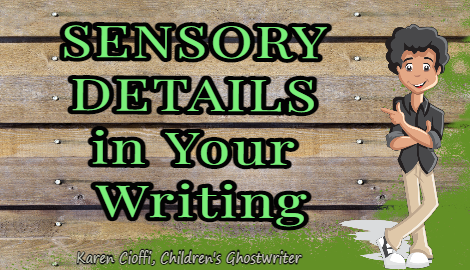Every author wants their story to bring the reader into the world they created. The reader should lose themselves in the story.
But how do you accomplish this?
Use sensory details.
According to Master Class, “Sensory imagery involves the use of descriptive language to create mental images.” (1)
Sensory details can enhance the character’s depth as well as the setting. It’s these details that helps connect and engage the reader emotionally.
So, what are the five senses?
Sight, sound, taste, touch, and smell.
These senses help the reader experience what the character is experiencing, and they’re all equally important, although, two are used a lot more than the other three.
SIGHT
Most writing is full of this sensory detail – a story wouldn’t survive without it.
Some examples of this sensory description:
-She peered out from behind the door. The intruder was looking for something, only she didn’t know what.
-She looked everywhere but at Jeremy.
-With his eyes glued on the finish line, he pictured himself bursting through the ribbon.
-She glared at Ryan, causing him to back away.
-Pete headed toward the door but stopped short when he spotted Jayne. “This is my chance.”
SOUND
Sound would be next in line of the most used sensory detail. It would be difficult to have a story without it.
Here are some examples:
-She jetted off the moment she heard them coming.
-His anger rose as he listened to Shawn.
-She moved closer to the door, trying to hear what was going on.
-He heard the thunder drawing closer.
-She listened carefully to the instructions.
-He froze when he heard a hissing sound; that snake was too close.
The other three senses, taste, touch, and smell, aren’t used as often, but they should be used more than they are. Each sense brings the reader further into the story and helps make that character-reader connection stronger.
TASTE
Taste can trigger old memories, making an even deeper connection with the reader.
Here are some examples.
-After losing his sense of taste, he craved salty, spicy, and sweet foods. Anything to help awaken his taste buds.
-Cupcakes, cakes, pies, pastries, and even breads lined the counter and shelves. Seth fixated on a chocolate cupcake with fluffy white icing. His mouth watered.
LOL My mouth watered writing that one.
-The bag was full of twigs, rocks, grasses, leaves, and other yucky stuff you’d rake up from your yard and throw out. After boiling it for two hours, as instructed, I took a sip. It tasted as I imagined it would; it tasty like dirt.
This is from my experience with COVID-19. My acupuncturist created a concoction that was supposed to help get over the virus and prevent long-lasting symptoms. The scene with the tastebuds was also from that experience.
-One bite of the lasagna and memories flooded in, bringing her back to dinner at her grandmother’s.
TOUCH
Aside from conveying what the object being touched feels like, the sensory detail touch can show hesitation, fear, happiness, anxiety, confirmation, be a replacement for a dialogue tag, and more.
Words like slimy, prickly, hard, smooth, soft, heavy, light bald, hairy, blunted, fluffy, jagged, help describe touch or the sensation of something touching the character.
Here are a few examples.
-She grabbed the mug from the microwave and a piercing pain immediately shot through her fingers.
-An icy cold wind whipped at his face.
-She put her hand in the bucket. A slimy cool gook wrapped around it.
-The warm stickiness of his blood oozed through his fingers as he held his hand firmly over the wound.
-Here’s one from my chapter book, “Walking Through Walls:”
“In a matter of seconds, he felt a thickness all around him, like walking through sand.”
But there’s also how the character touches.
-He ran his fingers over the wood he had just finished sanding.
-Josh fiddled with the rock he always carried in his pocket as he tried to think of something to say.
-Mayra wrapped her baby in the soft bath towel and held him close.
-Ryan put his hand over his little brother’s mouth. “Shh. If they hear us, we’re goners.”
-Alisha gently massaged her Bernedoodle’s ears, which quickly calmed him down.
SMELL
Smell is another sense that can trigger memories, possibly even more so than taste.
-The heavy perfume smell made him gag.
-The aroma of flowers permeated the room, only not in a good way, in the way it smells at a funeral home. There’s something about those beautiful, fragrant flowers in a room with death.
-Jenna held her nose. “What’s that awful stench?” It took only a second for her to realize that the family didn’t walk their dog; the yard was the doggy dumping ground.
-Wang had walked this path hundreds of times but today the aroma from the lemon lilies caught his attention.
SUMMING IT UP
Using sensory details in your stories helps show rather than tell, and using these details brings another level of emotional engagement for the reader.
Why not go over your story and see where you can enliven it with sensory details.
Note: Some of these examples can also be used as writing prompts.
Reference:
(1) https://www.masterclass.com/articles/sensory-imagery-in-creative-writing
I’m a working children’s ghostwriter, rewriter, and coach. I can help turn your story into a book you’ll be proud to be author of, one that’s publishable and marketable. You can contact me at: kcioffiventrice@gmail.com. Or, you can give me a call at 834---347---6700 Or, if you’d rather do-it-yourself, check out my book, How to Write a Children’s Fiction Book.
MORE ON WRITING
Get Your Book Found on Amazon Fiction Writing – Do it Right Should You Really Write a Book?



1 thought on “Examples of Writing Using Sensory Details”